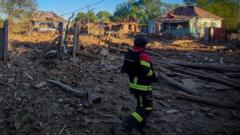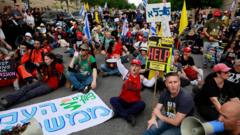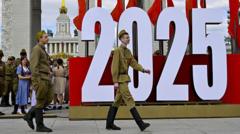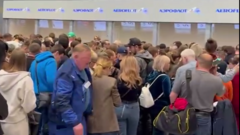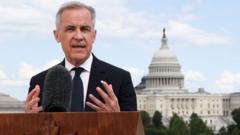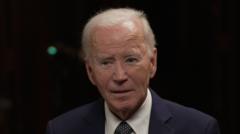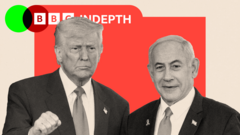As Ukraine's military adjusts to the dynamics of war, the retreat from Sudzha highlights issues of disorganization and communication failures. Artem Kariakin, a soldier directly involved, described the chaotic situation during their withdrawal from the Russian town. Prior to the retreat, his unit had engaged in regular operations across the border, but they found their exit fraught with difficulties, primarily due to inadequate communication and equipment failures.
### Ukraine's Chaotic Withdrawal: Soldiers' Perspectives on the Kursk Retreat
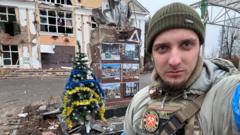
### Ukraine's Chaotic Withdrawal: Soldiers' Perspectives on the Kursk Retreat
Amid ongoing tensions between Ukraine and Russia, soldiers recount their chaotic retreat from Sudzha, revealing insights about operational challenges and the complexities of international diplomacy.
Kariakin reflected on the last moments of their mission, sharing how their retreat included dodging Russian drones and navigating a landscape marred by the remnants of warfare. He noted that while their withdrawal seemed disorganized, the offensive leading to their retreat had succeeded in rerouting Russian forces, even if it put Ukrainian troops at risk.
As high-level talks occur between U.S. and Russian leaders, such as President Trump and President Putin, soldiers like Kariakin express disdain over the disconnection between political negotiations and the realities faced on the ground. Dismayed about potential compromises affecting their home region now under occupation, Kariakin shows skepticism regarding Western leaders' ability to influence the conflict positively.
Additionally, another soldier, Serhiy, who participates in ongoing cross-border raids against Russian forces, argues that these actions aim to maintain operational pressure despite setbacks. He voices concern over inadequate European military support should U.S. involvement wane.
While both soldiers exhibit hope for a resolution to the conflict, they underscore that peace must not come at the expense of territorial integrity. As the war progresses and international negotiations continue, their stories illustrate the personal stakes of a conflict that remains far from resolution.
###
Article Text:
Until just over a week ago, Artem Kariakin and his unit were making routine incursions into the Russian town of Sudzha. They documented their last retreat from Russia's Kursk region, sharing footage of burnt military and civilian vehicles. A soldier on guard with a shotgun keeps watch as a drone approaches, but thankfully, the explosive charge isn’t strong enough to halt their escape.
Kariakin recalls the upheaval of their retreat, labeling it "not well organised" and "chaotic." He attributes the disarray to the delayed order to withdraw and the breakdown of their communication infrastructure, particularly the Starlink satellite systems, which failed inside Russian territory. Despite the complications, he considers the Kursk offensive a strategic success, as it forced a diversion of Russian forces from the east.
The backdrop of this chaos contrasts sharply with diplomatic discussions occurring between U.S. President Donald Trump and Russian President Vladimir Putin, which, to Kariakin, feel largely absurd. He expresses disappointment over potential compromises that could see regions like his home of Luhansk traded away, a sentiment that deeply resonates with the sense of urgency among Ukrainian forces.
Serhiy, another soldier, contributes to strategic raids against Russian positions, demonstrating the determination to press on even as threats linger close to the border. During a nighttime mission, he encounters the dangers looming in the form of drones and artillery, all while trying to recover damaged military vehicles to bolster Ukraine's defenses.
The reliance on U.S. support underscores the tension regarding the future of military aid to Ukraine, especially as discussions hint at possible peace treaties. With European nations yet to establish a robust coalition to address Ukraine’s security needs independently, both Kariakin and Serhiy voice fears that any ceasefire could lead to untenable terms for Ukraine.
While they both yearn for peace, the priority remains clear—territorial integrity and national security must be non-negotiable. As the conflict continues, the soldiers' experiences paint a vivid picture of the challenges they face amid a shifting geopolitical landscape.
As high-level talks occur between U.S. and Russian leaders, such as President Trump and President Putin, soldiers like Kariakin express disdain over the disconnection between political negotiations and the realities faced on the ground. Dismayed about potential compromises affecting their home region now under occupation, Kariakin shows skepticism regarding Western leaders' ability to influence the conflict positively.
Additionally, another soldier, Serhiy, who participates in ongoing cross-border raids against Russian forces, argues that these actions aim to maintain operational pressure despite setbacks. He voices concern over inadequate European military support should U.S. involvement wane.
While both soldiers exhibit hope for a resolution to the conflict, they underscore that peace must not come at the expense of territorial integrity. As the war progresses and international negotiations continue, their stories illustrate the personal stakes of a conflict that remains far from resolution.
###
Article Text:
Until just over a week ago, Artem Kariakin and his unit were making routine incursions into the Russian town of Sudzha. They documented their last retreat from Russia's Kursk region, sharing footage of burnt military and civilian vehicles. A soldier on guard with a shotgun keeps watch as a drone approaches, but thankfully, the explosive charge isn’t strong enough to halt their escape.
Kariakin recalls the upheaval of their retreat, labeling it "not well organised" and "chaotic." He attributes the disarray to the delayed order to withdraw and the breakdown of their communication infrastructure, particularly the Starlink satellite systems, which failed inside Russian territory. Despite the complications, he considers the Kursk offensive a strategic success, as it forced a diversion of Russian forces from the east.
The backdrop of this chaos contrasts sharply with diplomatic discussions occurring between U.S. President Donald Trump and Russian President Vladimir Putin, which, to Kariakin, feel largely absurd. He expresses disappointment over potential compromises that could see regions like his home of Luhansk traded away, a sentiment that deeply resonates with the sense of urgency among Ukrainian forces.
Serhiy, another soldier, contributes to strategic raids against Russian positions, demonstrating the determination to press on even as threats linger close to the border. During a nighttime mission, he encounters the dangers looming in the form of drones and artillery, all while trying to recover damaged military vehicles to bolster Ukraine's defenses.
The reliance on U.S. support underscores the tension regarding the future of military aid to Ukraine, especially as discussions hint at possible peace treaties. With European nations yet to establish a robust coalition to address Ukraine’s security needs independently, both Kariakin and Serhiy voice fears that any ceasefire could lead to untenable terms for Ukraine.
While they both yearn for peace, the priority remains clear—territorial integrity and national security must be non-negotiable. As the conflict continues, the soldiers' experiences paint a vivid picture of the challenges they face amid a shifting geopolitical landscape.







